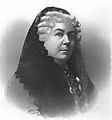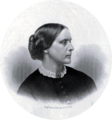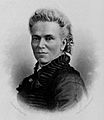History of Woman Suffrage facts for kids
History of Woman Suffrage is a very important book series. It was created by Elizabeth Cady Stanton, Susan B. Anthony, Matilda Joslyn Gage, and Ida Husted Harper. Published in six large books from 1881 to 1922, it tells the story of the women's suffrage movement. This movement was all about women gaining the right to vote, mainly in the United States.
The series has more than 5,700 pages! It's a main source of information about the women's suffrage movement. It covers everything from the beginning until 1920. That's when the Nineteenth Amendment was added to the U.S. Constitution. This amendment gave women across the U.S. the right to vote.
The book was written from the point of view of the group led by Stanton and Anthony. Because of this, it doesn't cover rival groups or other leaders as much. Susan B. Anthony knew the project probably wouldn't make money. So, in 1885, she used money she received to buy the rights to the books from the other authors. She also bought the printing plates from the publisher. As the only owner, she published the books herself. She gave many copies to libraries and important people. In her will, Anthony left the printing plates and all existing books to the National American Woman Suffrage Association.
Contents
Creating the Books
Susan B. Anthony and Elizabeth Cady Stanton were leaders of the National Woman Suffrage Association (NWSA). They started the idea of writing this history in 1876. This project took up a lot of their time for the next ten years. Anthony also kept busy with speeches and other activities for women's voting rights.
At first, they thought it would be a small book that would take only four months to write. But it grew into a huge work of over 5,700 pages. It took 41 years to complete! The last parts were finished in 1922, long after Stanton (who died in 1902) and Anthony (who died in 1906) had passed away.
In the introduction, the authors wrote that they hoped their work would help someone else later. They wanted a future writer to create an even more complete history of "the most important reform that has ever happened." They called it "the first organized protest against the unfairness that has affected half of the human race."
The first book is dedicated to early women leaders in the movement. Mary Wollstonecraft, who wrote A Vindication of the Rights of Woman in 1792, is listed first.
Early Volumes and Authors
The first three books cover the movement's history from its start until 1885. These were written and edited by Stanton, Anthony, and Matilda Joslyn Gage.
- Volume 1 (1848–1861) came out in 1881.
- Volume 2 (1861–1876) was published in 1882.
- Volume 3 (1876–1885) appeared in 1886.
Some early parts of the book first appeared in Gage's newspaper, The National Citizen and Ballot Box.
Anthony had saved many historical items for years. These included letters and newspaper clippings about the women's suffrage movement. In 1876, she sent several boxes of these materials to Stanton's house in New Jersey. Anthony then moved in herself to start working on the project with Stanton.
Anthony didn't enjoy this kind of writing work. She wrote in her letters that the project "makes me feel growly all the time." She added, "No warhorse ever panted for the rush of battle more than I for outside work. I love to make history but hate to write it."
Working together sometimes led to disagreements. Stanton's daughter, Margaret, said that "Sometimes these disputes run so high that down go the pens." She described them walking off in opposite directions. But then, she would see them "walking down the hill, arm in arm."
When Stanton was sick in 1881, her daughter Harriot helped. Harriot finished her mother's editing work for Volume 2. Harriot also noticed that Anthony and Stanton had no plan to cover the history of the American Woman Suffrage Association (AWSA). This group was a rival to their NWSA. So, Harriot wrote that 107-page chapter herself. She gathered information mainly from the Woman's Journal, a newspaper published by the AWSA.
Historian Ellen Carol DuBois said the first books were "very broadly conceived." She noted they combined Stanton's wide-ranging ideas, Anthony's organizing skills, and Gage's understanding of history. Anthony managed the business side of the project. Stanton wrote much of the text and shared her view of history. Gage wrote several essays, including one about how Christianity treated women throughout history. Gage also found many historical documents for the project.
Besides telling the story of the movement's activities, the first books included memories from leaders. They also looked at why women's conditions were the way they were. The books contained many original materials. These included letters, newspaper clippings, speeches, court records, and meeting reports. Volume 3 included essays from local women's rights activists. These essays gave details about the movement in different states. Anthony insisted that the books be indexed by a professional. They also included expensive pictures of women's rights leaders.
Later Volumes
In 1885, Anthony received $24,000 from Eliza Jackson Eddy. This money helped finish the first three books. Anthony knew the project likely wouldn't make a profit. So, she paid Stanton and Gage for their shares of the book rights. She published Volume 3 in 1886, listing herself as the publisher. She also bought the printing plates for Volumes 1 and 2 from the original publisher. She reprinted them in 1887, again listing herself as publisher. Anthony gave away over 1,000 copies at her own cost. She mailed them to political leaders and libraries in the U.S. and Europe. Publishing the first three volumes cost Anthony about $20,000.
Volume 4 covers the period from 1883 to 1900. Anthony published it in 1902 when she was 82 years old. The editors are listed as Anthony and her younger helper, Ida Husted Harper. But Harper did most of the work. (Anthony also chose Harper to write her life story.) The women's suffrage movement was becoming more accepted. For example, Harvard University ordered Volume 4. Less than twenty years earlier, Harvard had refused free copies of the first three books and sent them back.
Publishing the books herself caused some problems for Anthony. One issue was finding space for all the books. She had to limit the large number of books she stored in her attic. The weight was so much that it threatened to make the house collapse!
Volumes 5 and 6 were published in 1922 by the National American Woman Suffrage Association (NAWSA). This was long after Anthony's death in 1906. Harper wrote and edited these two books. They cover different parts of the period from 1900 to 1920. That's the year the Nineteenth Amendment was approved. This amendment is often called the Susan B. Anthony Amendment. It stops anyone from being denied the right to vote because of their sex.
The last three books give detailed information about the NAWSA. They document its meetings, leaders, reports, and activities across the country and in each state. The NAWSA was formed in 1890. It was a merger of the National Woman Suffrage Association and the American Woman Suffrage Association. Anthony and Stanton led the first group. The second group was their rival for twenty years, led by Lucy Stone. Anthony became the main leader in the combined organization. The last three books do not discuss conflicts within the women's movement during this time. Instead, they suggest that the movement's victory was sure to happen, thanks to a few talented leaders.
In her will, Anthony left the printing plates for the History of Woman Suffrage and all existing books to the National American Woman Suffrage Association.
In 1978, Mari Jo Buhle and Paul Buhle created a shorter version. They condensed the most important parts of the huge History of Woman Suffrage into The Concise History of Woman Suffrage. It was published as a single book with fewer than 500 pages.
Limitations of the History
The History of Woman Suffrage does not fully cover all groups and people. It mainly focuses on the leaders Susan B. Anthony and Elizabeth Cady Stanton. It only partly shows the role of Lucy Stone. She was an important women's rights leader and a leader of the AWSA, which was a rival to Stanton and Anthony's NWSA.
Stanton asked Stone to help with the history project by writing about her own part in the movement. But Stone refused. She said the project should wait for a later generation. She believed that none of the leaders from the two rival groups could write a fair history. So, Stone gave Stanton only a little information about her activities. She also asked Stanton not to write a short biography of her for the book.
However, a 107-page chapter about the history of the AWSA was included. Stanton's daughter, Harriot Stanton Blatch, put it together in 1882. The History of Woman Suffrage also gives very little information about the activities of the National Woman's Party. This group was founded in 1913 by Alice Paul and other activists. They had been members of the NAWSA before.
Historian Ellen Carol DuBois says that for many years, the History of Woman Suffrage shaped how people viewed the women's movement. She called it a "frozen account of the past." This history was seen as a celebration of victory, as if it was always meant to happen.
Historian Lori D. Ginzberg said that in this story, Stanton alone asked for women to vote, and Anthony led the effort. She noted that it made it seem like there was only one main organization (theirs). Historian Lisa Tetrault said that Stanton and Anthony created a single, easy-to-understand story. But in reality, the movement was "a sprawling, multifaceted campaign." Tetrault said they put themselves and their friends at the center of the story. They played down or ignored the roles of Stone and others who didn't fit their story.
Scholarly research into women's history began to move beyond this view. This happened with the publication of Eleanor Flexner's Century of Struggle in 1959.
Why This Book is Important
In her book Woman Suffrage and Women's Rights, historian Ellen Carol DuBois said, "There is nothing in American reform quite like History of Woman Suffrage." She described it as a long, careful effort by activists to make sure their place in history was remembered.
The Encyclopedia of Women's History in America called the History of Woman Suffrage "the fundamental primary source for the women's suffrage campaign." Lori D. Ginzberg also called it "the major, if not the definitive, collection of primary source materials on the nineteenth-century movement."
Tetrault said that even more than 125 years after they were published, these books are still a very important source. For much of that time, they have been the best collection of published documents about the women's suffrage movements in the 1800s.
Images for kids
The History of Woman Suffrage has over 80 pictures of women activists. Here are images of its four main contributors:





